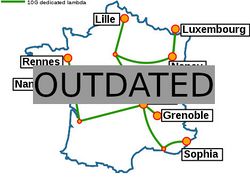Grid5000:Home: Difference between revisions
Ddelabroye (talk | contribs) No edit summary |
No edit summary |
||
| Line 7: | Line 7: | ||
Key features: | Key features: | ||
* provides '''access to a large amount of resources''': 1000 nodes, 8000 cores, grouped in homogeneous clusters, and featuring various technologies: 10G Ethernet, Infiniband, GPUs, Xeon PHI | * provides '''access to a large amount of resources''': 1000 nodes, 8000 cores, grouped in homogeneous clusters, and featuring various technologies: 10G Ethernet, Infiniband, Omnipath, GPUs, Xeon PHI | ||
* '''highly reconfigurable and controllable''': researchers can experiment with a fully customized software stack thanks to bare-metal deployment features, and can isolate their experiment at the networking layer | * '''highly reconfigurable and controllable''': researchers can experiment with a fully customized software stack thanks to bare-metal deployment features, and can isolate their experiment at the networking layer | ||
* '''advanced monitoring and measurement features for traces collection of networking and power consumption''', providing a deep understanding of experiments | * '''advanced monitoring and measurement features for traces collection of networking and power consumption''', providing a deep understanding of experiments | ||
Revision as of 08:25, 17 September 2018
|
Grid'5000 is a large-scale and versatile testbed for experiment-driven research in all areas of computer science, with a focus on parallel and distributed computing including Cloud, HPC and Big Data. Key features:
Older documents:
|
Random pick of publications
Five random publications that benefited from Grid'5000 (at least 2927 overall):
- Théophile Bastian, Hugo Pompougnac, Alban Dutilleul, Fabrice Rastello. CesASMe and Staticdeps: static detection of memory-carried dependencies for code analyzers. INRIA. 2024, pp.1-12. hal-04477227 view on HAL pdf
- Tristan Coignion, Clément Quinton, Romain Rouvoy. A Performance Study of LLM-Generated Code on Leetcode. EASE'24 - 28th International Conference on Evaluation and Assessment in Software Engineering, Jun 2024, Salerno, Italy. 10.1145/3661167.3661221. hal-04525620 view on HAL pdf
- Guillaume Schreiner, Pierre Neyron. SLICES-FR : l’infrastructure de recherche nationale pour l’expérimentation Cloud et Réseaux du futur. JRES 2024 - Journées réseaux de l'enseignement et de la recherche, Renater, Dec 2024, Rennes, France. pp.1-15. hal-04893845 view on HAL pdf
- Gustavo Salazar-Gomez, Wenqian Liu, Manuel Alejandro Diaz-Zapata, David Sierra González, Christian Laugier. TLCFuse: Temporal Multi-Modality Fusion Towards Occlusion-Aware Semantic Segmentation. IV 2024 - 35th IEEE Intelligent Vehicles Symposium, Jun 2024, Jeju Island, South Korea. pp.2110-2116, 10.1109/IV55156.2024.10588460. hal-04717193 view on HAL pdf
- Vania Marangozova, Angelo Gennuso. K8S Auto-Scaler Coordinators. Université Grenoble - Alpes. 2024. hal-04963348 view on HAL pdf
Latest news
Failed to load RSS feed from https://www.grid5000.fr/mediawiki/index.php?title=News&action=feed&feed=atom: Error parsing XML for RSS
Grid'5000 sites
Current funding
As from June 2008, Inria is the main contributor to Grid'5000 funding.
INRIA |
CNRS |
UniversitiesUniversité Grenoble Alpes, Grenoble INP |
Regional councilsAquitaine |


